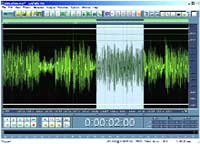
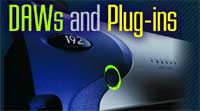
Digidesign's new Pro Tools HD system offers the benefits of 96 kHz audio, and many plug-in manufacturers are already supporting it.
|
The Who Wants to be a Millionaire? question this month is: What did audio post engineers, mixers and the lot do before digital audio workstations? If you can come close to answering that question, you've either been around for 10 or more years or you're a student of the science.
From nearly the day that digital audio workstations (DAWs) debuted, the face of audio post production dramatically shifted. Nowadays the tools serve as the norm rather than the exception and it would be a challenge to find a post facility that didn't feature at least one. Just as the popularity of the DAW has grown, so have the number of manufacturers. And that's nothing to speak of the host of companies that provide services and add-on products to manufacturers and customers alike.
Perhaps a fact that Digidesign's post products manager, Scott Wood, points out is most telling about the proliferation and future of DAWs in the market: "The Shrek release made more money on its opening weekend of DVD then it did in its initial theatrical release. When you start looking at numbers like that people see that it's real important to create your media at the highest resolution possible to enable that type of future returns when you need to re-purpose it," he says.
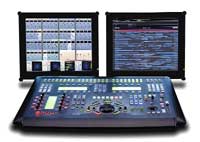
Fairlight is proud of its DREAM Station's worksurface, which goes beyond that of a mouse-driven DAW.
|
Michael Reddick of AMS Neve has seen an explosion of the popularity of the DAW and an increased pace of technological evolution. "The advances that have been made in the last two or three years across the board for DAWs have been quite startling," he says. The ongoing rate of change, he adds, is quite dependent on the improvement of PC technology. "I know that people do predict that we're going to hit a point where [there are] diminishing returns, where it's going to be harder to make things faster or bring in new innovations, but at the moment we're up to over 2 gig CPUs. I think the DAW rate of change of development is linked to that and there doesn't seem to be a slow down yet."
That said, Reddick is quick to point out this is an exciting time for DAWs. "Oh definitely. Things that three or four years ago were just out of reach now are, in fact, very easy," he states. "It's a great time."
With that in mind, this month's Post looks at the state of the DAW market and two of the most popular plug-in providers.
THE PLUG-INS
TC Works: The TC Works (www.tc-works.de) collection of plug-ins - and there are many of them - are designed to work with just about any flavor of DAW. Users of MOTU Digital Performer, Cubase and Logic will be better suited to purchase the Powercore set rather than the TDM plug-ins, explains Fred Kores, TC Works tech support for software and sales. "You can run TDM plug-ins with Digital Performer and Logic, but then you have to buy the TDM cards," he says. "You have to buy a whole Pro Tools system to work with that, so Powercore gives an easier and less expensive way to get quality plug-ins."
As for the new Pro Tools HD system, Kores reports, "That's going to take a few months to get ready, but Master X will be coming out at the end of summer and TC Tools is coming out at the end of fall."
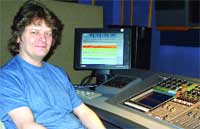
AMS Neve's Michael Reddick believes that recent DAW advancements are due to improvements in PC technology.
|
The Powercore suite of plug-ins (version 1.6 was released in April) includes TC MegaReverb, TC Chorus/Delay, TC EQSAT, TC Vintage CL (a compressor/limiter) and the TC VoiceStrip (a channel strip with a dynamics, gate, EQ and desser) and is built around all of TC Work's best algorithms, which takes a DSP card. "We also have the third parties developing for Powercore," Kores explains. "We don't have as many as Digidesign right now, but that's the direction that it's going. We're just trying to give the VST users the same ability to use the same plug-ins." To date, the third parties that are developing plug-ins for TC Works include Sony (Oxford EQs), Emagic, Access, Waldorf and the Desound VL2 multichannel valve interface.
Spark is TC Works' mastering suite that is a standalone, two-track editor that includes 22 plug-ins for analysis, distortion, synthesis, filter, as well as reverbs and delays. "Specifically for post production, Spark is designed for mastering and finishing," Kores explains. "It does have the capability to sync to video. In terms of SMPTE and timecode, it doesn't really stay locked like regular SMPTE stuff should, but if you have your video synced and you want to finish some of the audio in Spark, then you can take it in there and use it."
Waves: According to Bob Reardon, VP of sales for North and South America, Waves (www.waves. com) has two new products that will help post professionals: the Masters Bundle and Restoration. "Restoration is a suite of tools that does declicking, denoising, decrackle and hum and DC removal," Reardon explains. "People may look at that and say, 'Oh, that's for vinyl.' Yeah, we've had some people use it for vinyl quite successfully, but really it's been the post people who have saluted us on this."
It's been used to repair things such as digital overloads with declick, he adds. "I've had people use it for an offending thing like a bad transfer where the original SMPTE was not locked to the work clock. It drifts out and you get that click, then you get the high frequency scattery stuff and then you get another click," Reardon says. Then in a DAW the audio can be stretched to correct the sync. The plug-in runs on the CPU and is available for Mac and PC.
The Masters Bundle was designed with the mastering community in mind but can be used to finish a program. "The big thing in the Masters Bundle is the linear phase technology," Reardon explains. And that features nine different types of EQ curves.
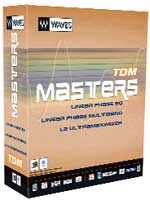
Designed for mastering applications, Waves' Masters includes an abundance of EQ options.
|
According to Reardon, Waves is ready for Pro Tools HD. "We're compatible with HD," he says. "Everything works at 44/48. Most things - we make 26 products now - work at 96 under TDM and a good list works at 192. The Native stuff, everything works at 44/48 and everything works at 96, and almost everything works at 192. The few that aren't will get sorted out in the next couple months."
THE DAWS
Digidesign: Big news in the DAW market is the release of Pro Tools HD from Digidesign (www.digidesign.com). Scott Wood, Digidesign's post products manager, says, "If you like Pro Tools you'll love HD. HD is a newer generation of hardware. It runs smoother on your system. It runs lighter on your computer. You'll find your system load, even running the same session, will be lighter." HD also features more DSP capability, more functionality inside the system for being able to up-sample and down-sample for delivery requirements. "You have realtime sample rate conversion on your digital inputs that are on the digital cards. You have more flexibility in the way that you set up a system. It's more than just 96 and 192K," Wood adds.
As for plug-ins, Woods reports that most of the third parties that develop for Digidesign are working on HD additions. The company actively recruits companies to build plug-ins for the Digidesign platform as well as an engineering group that assists the developers when they are building the plug-ins. One of the newest plug-ins, which was announced at NAB, is the Sonic Solutions NoNoise that will operate in realtime. "It's really the standard that people use for high-end professional noise reduction," Woods says. "Because it's held in automation in Pro Tools, when you get up to the final mix stage and you realize that you need a little more noise reduction, or a little bit less noise reduction, it's active right in your automation in your final process."

Phoenix's Syntrillium Software (www. syntrillium.com) has upgraded its low-cost, PC-based Cool Edit Pro digital editing/mixing release. Priced at $249, Version 2.0 adds realtime effects and track EQ functionality, along with disc-at-once CD burning, MIDI and video playback support, MTC master generation, six new DSP effects, loop-based music composition and a compressed loop file format. Syntrillium is also now offering a remote control option with its Red Rover multitrack interface ($129). The USB device allows users to control on-screen displays and provides access to all 128 tracks of the software tool.
|
A new feature in the Pro Tools 5.1.3 platform enables multiformat delivery from one Pro Tools session to another. "So you can take an Avid 24p session, OMF it to Pro Tools and play it in our workstation," explains Wood. "We've now added another feature that allows us to take that 24p picture and with one flip of a switch lay it back to 25 or 29.97. You could do that by speeding up and slowing down tapes in the past, and the ability to do PAL and NTSC deliveries with a single session was possible, but the difference here is that it's active with Machine Control." That comes in handy while getting multiple fixes and different versions in right at the last minute after the 25 and 29.97 master has been laid down. "You can select an area of the timeline, set it to 25, punch into the 25 master, flip to 29.97, punch into the same relative area of the 29.97 master all from one Pro Tools session," Woods explains.
Fairlight: Christopher Pelzar, CEO of Fairlight USA (www.fairlightesp.com), reports that the company's line of products are a different breed than most DAWs. "We are not a mouse and keyboard driven product," he says. "We're a dedicated control surface driven product. The direct hardware controller that we provide, the DREAM Satellite product, is faster than anything anybody can do with a mouse and keyboard. So, if you're a professional billing out your time, you can get more work done with the DREAM product and you don't have to pay any more for it."
In addition to the DREAM Satellite system, Fairlight offers the DREAM Station, which includes recording, editing and mixing solutions in formats up to 7.1. The DREAM Console is a digital audio mix console complete with automation and a 48-track disk recorder and editor. "The DREAM Station is probably going to be the one that makes a lot of sense to people because, for not too much more than the price of a 48-track editor, you also get a 56-channel digital mixer," he says. "That's probably the most cost effective solution for post operations these days."
Fairlight supports DSP plug-ins, but they are handled in a different way. Unlike other plug-ins for the Mac and PC platforms, where the processor is used, Fairlight provides a separate CPU that runs all the plug-in software. This directly interfaces with their equipment via menus and pop-up screens that come up on the control surface as well as the screen. "The advantage to that is we can run many more plug-ins at one time," he says. "Plus, remember that plug-ins are developed by third parties and they don't operate 100 percent well all the time. So, if you've got a plug-in on a host-based system that has a problem it could take down your entire system. Ours is on a separate CPU, so if a plug-in is having a problem it will really only affect the plug-in audio portion of that and not your edit or mix."
Mackie: Mackie (www.mackie.com) recently acquired the Soundscape 32, an embedded hard disk recorder that's a different approach to DAWs. "The main difference between a Soundscape platform and anything else like Pro Tools or Digital Performer is that Soundscape runs peripheral to a computer," explains recording products and market development manager Dan Moore. "It is a standalone rack unit that records all PCM data straight to the drives and I/Os right from that unit. There is no interfacing between actually writing audio information to the drives and the PC motherboard. The PC is used for a controller."
The key to the Soundscape's success, Moore adds, is that the instability of an off-the-shelf PC is removed. "All of the housekeeping tasks that normally go along with a PC or Mac are eliminated from the stream of audio into the drive and out of the drive."
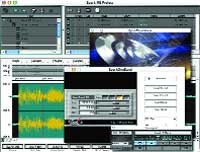
Spark is TC Works' mastering suite, including plug-ins for analysis, distortion, sythesis, reverbs and delays.
|
What makes the Soundscape attractive to those in the broadcast field is that it integrates both audio and video production, as well as sound to picture applications. "It supports full frame, high resolution video capturing through a number of video cards, one of which is the DPS Velocity Reality Card," Moore says. Mackie is in the process of working with other video capture companies to expand its range.
The Soundscape box supports all of the standard post production applications in terms of synchronization and editing capabilities. It also features an EDL compatibility application that allows users to integrate Soundscape into all other EDLs. "Compatibility is the key convenience to the current audio engineer," Moore reports. "Soundscape really breaks down those barriers and allows you to export a Soundscape session file as a number of different EDL formats. So, that's one that really makes it a key tool for post production."
And with the UAD-1, Mackie is offering a range of plug-ins such as Kind of Loud's RealVerb Pro, Teletronix LA-2A, 1176LN and the CS-1 Channel Strip which includes an EQ, compression and a delay modulator.
AMS Neve: The AMS Neve (www. ams-neve.com) AudioFile SC is the first AudioFile with a Windows NT hub that is able to run proprietary and third-party plug-ins, says editorial products manager Michael Reddick. "We started with developing our own set of plug-ins using algorithms that we already had, like the Logic, DFC EQ, the Capricorn EQ and dynamics from that series of console," he explains. "Then we branched out to see what else we could do, so we moved on to doing some creative stuff like distortion, ring modulation and resonators." The first set of third-party plug-ins the company offered was the suite of Cedar products, such as Denoise and Declick.
The new set of plug-ins will help with situations with bad background or machine noise, Reddick explains. "Stuff that the dubbing mixer doesn't really want to know about at the mixing stage."
For the AudioFile itself, Reddick reports the company has developed a tool that enables direct import from Pro Tools 4 and 5 session files. "What's been said to us is that OMF is great, but it has to be a pre-planned thing," he explains. "People just turn up with Pro Tools session files expecting you to be able to deal with it. So, we've got the AudioFile into a situation where it can."The AudioFile SC's NT hub now allows it to import OMF and export OMF files over a network and another new tool enables track linking for stem editing. "It takes the concept of editing tracks to a higher level, so you can link tracks together for surround work," Reddick explains. "You can link five or six tracks together as a stem and any trim that you do will be applied across all of them. That makes that kind of editing a lot easier to deal with."
WaveFrame: Driven by the desire to remain competitive, WaveFrame (www. waveframe.com) introduced the WaveFrame/7 late last spring. It was a complete overhaul of the software and hardware, explains director of customer support David Hart. Rather than throwing out the baby with the bath water, Hart says the company kept "all the tools that have been part of WaveFrame since the late '80s, but we had to add plug-in support, more track play and recordability and more SCSI bandwidth."
WaveFrame/7 runs on Windows 2000 and includes the Mykerinos digital audio DSP hardware made by Merging Technologies. "It's a full 32-track, 24-bit I/O DAW," Hart says. "We have three I/O methods to get in and out of the box, most standard is the ADAT optical, AES/EBU 24 in and out option and a MADI option for film consoles."
The WaveFrame is used for dialogue editing, ADR recording and editing, Foley recording and editing as well as effects design. The move to the new platform enables WaveFrame's use of Direct X plug-ins, and Merging is in the process of developing a VST plug-in paradigm, Hart says.
"The other big component of our system is file translation," Hart reports. "We want to be compatible with anything out there that people use alongside our system." Currently WaveFrame/7 boasts four import/export options for OMF 1 and 2, WaveFrame/6 (which makes the system compatible and interchangeable between WaveFrame systems all the way back to 1987), OpenTL and AES 31. "We're trying to ride the wave and keep tabs on the market and other companies that want - driven by the Hollywood community - to get AES 31 out there as a more robust or dependable standard than OMF," he says.